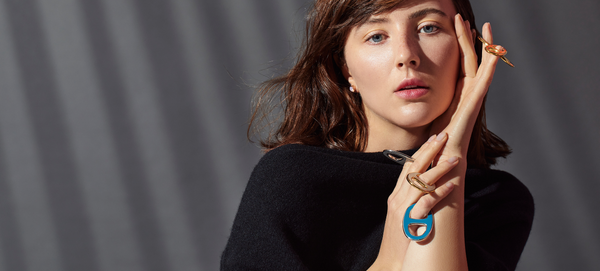Beyond Scarf Textile Glossary
Silk
History & Production
With an illustrious history rooted in nobility and folklore, it’s fitting that silk is revered as one of the world’s most luxurious fibers. According to Chinese legend, empress Lei-Tzu serendipitously discovered silk in 2696 BC while sipping tea in the imperial gardens. As she lounged beneath a mulberry tree, a cocoon fell into her steaming cup. Lei-Tzu plucked the cocoon from her drink and it began to unravel; long, shimmering threads emerged from the cup, yard by yard. Enamored by the beauty and strength of the silk filaments, the empress developed sericulture—the rearing of silkworms for silk production—and invented the silk loom.
China reigned as the leading manufacturer of silk and guarded sericulture as a well-kept secret for over 30 centuries. Today silk remains a symbol of luxury, and production has expanded worldwide to India, Japan, Korea, Thailand, Vietnam, Uzbekistan and Brazil.
Properties
Originally reserved for Chinese royalty, silk was unparalleled in its luster and luxurious handle. The same holds true today as the fiber exhibits a range of desirable properties; silk is the strongest natural fiber and serves as a non-conductor, so it feels cool in the summer and warm in the winter. The fiber has good elasticity and recovery after stretching and features a moderate resistance to wrinkling. The smooth surface repels dirt while lending the textile a fluid feel, excellent drapability and a luminous sheen. Silk also exhibits good absorbency and affinity for dyes, making it ideal for bright color palettes and prints.
Weaves
From glossy Habotai silk to ribbed faille and airy georgette, silk can be woven in a variety of constructions for a varied look and feel. The most common weaves used in our scarves include:
Chiffon: a lightweight and airy plain-woven fabrication.
Satin: a fluid fabric with a glossy surface and matte back.
Charmeuse: a lightweight fabric woven with a satin weave for a lustrous and reflective surface and a matte reverse.
Twill: a woven fabric featuring a pattern of parallel diagonal ribs (can vary in weight).
Wool
History & Production
The story of wool began many millenniums ago when primitive humans cloaked themselves in woolly hides from foraged animals as means for warmth and protection. Prized for thousands of years as one the world’s most dynamic natural fibers, wool was being spun into cloth by tribes from Northern Europe earlier than 10,000 BC. The development of the spindle and loom for spinning yarns and weaving fabric provided new applications for producing woolen clothes more efficiently. By the twelfth century, wool was England’s most valued asset and the country’s greatest wealth came from exports of raw wool. Today the top wool-producing countries include Australia, China, New Zealand and the United States.
Properties
Obtained from a variety of animals including sheep, goats, muskoxen and rabbits, wool has sealed its status as one of the most versatile and desired textiles due to its expansive properties. Used in everything from apparel to medical textiles and military applications, the fiber is revered for its high durability, moisture-wicking abilities, wrinkle resistance, shape retention and comfort. At Beyond Scarf, our scarves are crafted from the finest wools, resulting in incredible softness, superior drape, a lustrous appearance and a luxurious handle.
Weaves and Knits
Wool can be knitted, woven or felted into cloth. Knitted fabrics are created by interlooping a single continuous yarn, while woven fabrics are produced by intersecting warp and weft yarns. Felting—one of the oldest fiber crafts—is the process of matting, condensing and pressing wool fibers to form cloth. Many of Beyond Scarf’s wool scarves are crafted using a fine twill construction, a textile weave that produces a diagonal rib effect.
Cashmere
History & Production
Cashmere originated in the Himalayan regions of Central and Southwest Asia, where the earliest documented usage dates back to the 14th century. Cashmere derived its name from Kashmir, a region now in northern India that was renowned in Europe during the nineteenth century for its production of luxurious shawls. Cashmere goats have since settled in other mountainous countries including China and Mongolia. By growing thick, insulating coats, cashmere goats thrive in the frigid mountain winters. Come spring when natural shedding occurs, the goats are combed for their downy undercoat fibers that produce incredibly soft and lofty wool. It takes a single goat one year to produce enough cashmere for a scarf.
Properties
There’s good reason why cashmere has been coined “the golden fleece” and “the diamond fiber”. With a silky handle and unparalleled softness—combined with a manually rigorous gathering and production process—cashmere is the epitome of true luxury. The fiber is naturally lightweight but boasts superior warmth and insulation properties, making it ideal for a range of seasons and climes. Cashmere also boasts good dyeability, making it possible to dye and print cashmere textiles in a wide range of colors.
Weaves and Knits
Like wool, cashmere can be knitted or woven into cloth. At Beyond Scarf we carry a variety of cashmere designs including scarves, cowls and ponchos that have been crafted using a luxuriously dimensional rib-knit construction.
Blends
While natural fibers boast a myriad of desirable properties, they are often blended with synthetic fibers to strengthen and complement their inherent attributes. The result can include superior color fastness, stunning prints, optimum softness, increased drapability and more. At Beyond Scarf we carefully select blends that mix luxurious natural fibers with high-grade synthetics such as modal or premium viscose.
Modal
Considered a variety of rayon, modal is a bio-based fiber crafted from the reconstituted cellulose of beech trees. While it bears similar properties to cotton and can be used on its own, modal is highly desirable in blends for its added durability, increased breathability, shrink resistance, superior softness and drape. A selection of our silk, linen and cashmere scarves is blended with modal, resulting in an opulent handle and brilliantly colored designs.
Viscose
Crafted from regenerated cellulose produced from plants such as bamboo, soy and sugar cane, viscose has a silk-inspired feel and retains rich and vibrant colors. Viscose is blended into a small range of our silk scarves for its increased abrasion resistance and ability to be easily dyed in a range of spectacular pigments.

